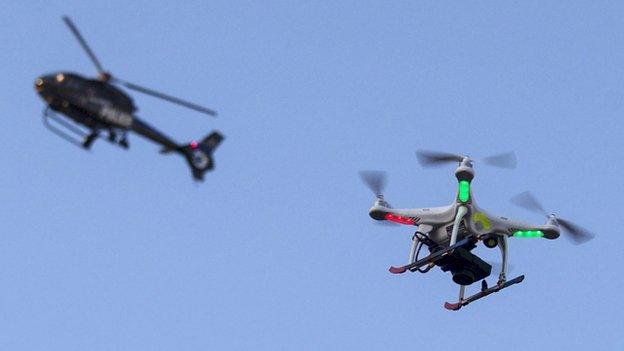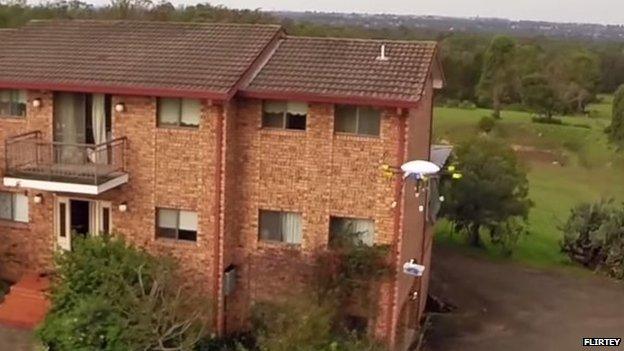Can technology keep our skies safe from nuisance drones?
- Published

Drones have been getting too close to planes and helicopters
Hobby drones. Unmanned aerial vehicles. Remote-controlled copters.
Call them what you will, they're becoming a nuisance.
A minority of irresponsible users has been flying them too close to aeroplanes and helicopters; wandering into restricted military airspace; spying on neighbours; disrupting sporting events; and even injuring people.
It was only a matter of time before some trigger-happy vigilante shot one of the pesky privacy invaders out of the sky.
Regulators and law enforcers are struggling to cope with the growth in their popularity, increasing the likelihood that heavy-handed legislation could stifle innovation in a sector that has great commercial potential for businesses large and small.
"This is a very hot topic," said Gary Clayton, chair of the Unmanned Aerial Vehicle Systems Association, a trade body representing several hundred commercial drone users.

A Serbia v. Albania football was interrupted after a flag-carrying drone flew over the stadium
"Operators with no training and no understanding of airspace could discredit the whole industry."
So can technology help police our skies?
Safety features
The largest hobby drone maker in the world is DJI, a Chinese company that has about an 80% share of the market.
European marketing director Kevin Gordon told the BBC that a number of safety features were already included in the firm's latest Phantom quadcopter drones.
"You cannot fly to the point where the batteries are exhausted," he said. "If you get to 10% of battery life it will automatically return to home and land."
Another feature is geo-fencing - using onboard GPS and mapping systems to stop drones flying into restricted airspace.
"This is a solution to reduce airport incursion incidents," he said. "It's important that we don't allow people to fly in places they shouldn't."

Commercial uses for drones
-
Farming
×Drones are already being used extensively by farmers to monitor the health of their crops and livestock. Multi-spectral cameras can analyse the level of moisture in the soil, plant health, and spot areas of blight or insect infestation. This saves them time and money and can help improve crop yields.
-
Photography
×Advanced drones equipped with high-definition rotatable cameras, anti-shake technology, and the ability to track fast-moving action, are offering spectacular aerial photography and film-making capabilities for the news and creative media sectors.
-
Surveying
×Drones can reach places that are difficult and dangerous for humans to get to, and this is proving very useful in industry. Drones are now inspecting oil rigs, gas pipelines, electricity networks, chimneys, wind turbines, nuclear facilities, roofs - even underwater structures and cables. They are also useful for creating 3D maps of rural and urban landscapes.
-
Deliveries
×Retail giant Amazon envisages your online order being buzzed to your front door by a fleet of delivery drones - once regulators allow it. Australian company Flirtey is also developing a drone delivery service, as are many others. But drones could also help deliver humanitarian aid and medicines to disaster areas and remote locations.

Swiss Post has been testing the viability of drone deliveries to remote, alpine villages
Farming: Drones are already being used extensively by farmers to monitor the health of their crops and livestock. Multi-spectral cameras can analyse the level of moisture in the soil, plant health, and spot areas of blight or insect infestation. This saves them time and money and can help improve crop yields.
Surveying: Drones can reach places that are difficult and dangerous for humans to get to, and this is proving very useful in industry. Drones are now inspecting oil rigs, gas pipelines, electricity networks, chimneys, wind turbines, nuclear facilities, roofs - even underwater structures and cables. They are also useful for creating 3D maps of rural and urban landscapes.
Photography: Advanced drones equipped with high-definition rotatable cameras, anti-shake technology, and the ability to track fast-moving action, are offering spectacular aerial photography and film-making capabilities for the news and creative media sectors.
Deliveries: Retail giant Amazon envisages your online order being buzzed to your front door by a fleet of delivery drones - once regulators allow it. Australian company Flirtey is also developing a drone delivery service, as are many others. But drones could also help deliver humanitarian aid and medicines to disaster areas and remote locations.

But he admitted that "it is technically possible to bypass the GPS", meaning that determined trespassers could still fly their drones where they shouldn't.
The latest drones also allow users to specify the geo-fence area, reducing the chance of inexperienced pilots losing control and flying their drones into people or buildings.
"The next generation of drones will be easier and safer to fly, compensating for pilot error - we view this tech as making flying safer," said Mr Gordon.
The BBC wanted to find out what Parrot, the second largest drone manufacturer, thought about these issues, but it was not willing to co-operate with this feature.
Air traffic control
While "return-to-home" and geo-fencing features are a step in the right direction, the proliferation of drones in our skies is likely to need a more comprehensive approach to policing and safety.
In the US, Nasa (the National Aeronautics and Space Administration) is co-ordinating the development of a traffic management system for unmanned aerial vehicles (UAVs) that fly below 500ft (152m).

Australian firm Flirtey aims to provide drone delivery services
The University of Nevada in Reno has partnered with Flirtey, an Australian drone delivery service, and UAV specialist Drone America, external, to test how such a system could work.
When there are hundreds of low-flying drones carrying out a range of duties, from deliveries to traffic monitoring, disaster relief to building inspections, we are going to need "sense-and-avoid" systems so they don't crash into each other, as well as flight corridors similar to those used by passenger aircraft.
Such a system will also need bang up-to-date terrain maps, dynamic route planning and weather data integration.
Not surprisingly then, Nasa thinks a prototype of its traffic management system will not be ready before 2019.
'Dangerous and illegal'
Meanwhile, the incriminating dossier of "drones behaving badly" grows fatter by the day.
This month, the US Federal Aviation Administration (FAA) reported that drone sightings by pilots had nearly trebled from 238 in 2014, to 650 this year so far.
Some of these drones were being flown at up to 10,000ft (3,050m), pilots reported.
"The FAA wants to send out a clear message that operating drones around airplanes and helicopters is dangerous and illegal," the FAA said in a statement.
Drone users have been warned they could face prison if they disobey rules on safe use, as Rory Cellan-Jones reports
"Unauthorised operators may be subject to stiff fines and criminal charges, including possible jail time."
Firefighters in California recently had to ground helicopters meant to douse forest fires because drone owners were flying their craft too close to the scene looking to record some dramatic video.
The US Forest Service was forced to conduct a poster campaign with the strapline: "If you fly, we can't".
And in the UK, the Civil Aviation Authority (CAA) has recorded seven "near misses" between passenger jets and drones, prompting calls for tougher sentences for amateur operators who endanger life.
'Raising awareness'
But how do you police drone use effectively?
The CAA regulations are clear, external: the operator of a hobby drone must keep the drone in sight at all times and not fly it above 122m (400ft). If it's a surveillance drone, you cannot fly it over or within 150m of any congested area or organised open-air assembly of more than 1,000 people.
But given that the latest, most sophisticated drones have a range of up to two miles and can be programmed to fly automatically along prescribed routes, enforcing such rules is no easy task.
Only a few irresponsible drone users have been prosecuted so far around the world, and no-one has yet been sent to prison.
WATCH: How consumer technology could help keep an eye on wildfires
CAA spokesman Richard Taylor told the BBC: "The CAA has brought two successful prosecutions in relation to the illegal flying of unmanned aircraft. However, the police and CPS [Criminal Prosecution Service] now deal with incidents involving the misuse or illegal operation of drones.
"The CAA retains responsibility for raising the awareness of safe drone operation and the risks posed to aircraft from inappropriate and irresponsible use."
But until the police have the means to identify drones remotely, and access to a central database of owners, it is hard to see how they will be able to catch the growing number of miscreants.
The European Union is certainly looking at these options, as well as the possibility of making built-in safety features mandatory.
Ironically, the onboard cameras most drones now come with, and users' propensity to share video footage online, are currently the best means to catch reckless operators.
Follow Matthew on Twitter: @matthew_wall, external